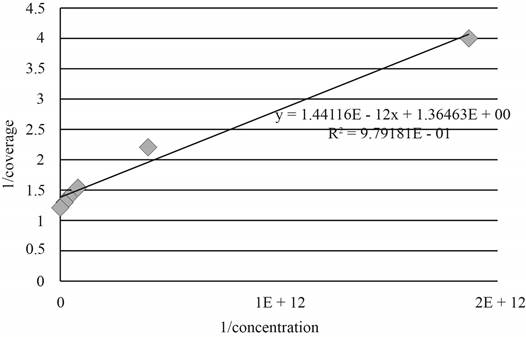
Concept explainers
Interpretation:
The validation corresponding to the fact that data of carbon monoxide coverage and pressure follows a Langmuir isotherm is to be stated. The equilibrium constant for the adsorption process is to be stated.
Concept introduction:
The isotherm model that describes the adsorption process, if an adsorbate acts as an ideal gas at the isothermal situation is known as Langmuir adsorption isotherm model. In the given isothermal situation, the partial pressure of the adsorbate is related to the volume of the adsorbate which is adsorbed on the solid adsorbent.
Answer to Problem 22.47E
The occurrence of the linear straight line between
The equilibrium constant for the adsorption process is
Explanation of Solution
The given temperature is
The given data of carbon monoxide coverage and pressure in torr is mentioned in the table below.
| Coverage | Pressure (torr) |
The concentration of carbon monoxide is calculated by the formula given below.
Where,
•
•
•
•
•
•
The value of universal gas constant is
| Pressure | Coverage | |||
The graph between

Figure 1
As, the plot between
The value of slope is predicted as
The value of equilibrium constant is calculated by the expression given below.
Substitute the value of slope in the above expression.
Therefore, the value of equilibrium constant is
The given data of carbon monoxide coverage and pressure follows a Langmuir isotherm.
The equilibrium constant for the adsorption process is
Want to see more full solutions like this?
Chapter 22 Solutions
Bundle: Physical Chemistry, 2nd + Student Solutions Manual
- For benzene, the ∆H° of vaporization is 30.72 kJ/mol and the ∆S° of vaporization is 86.97 J/mol・K. At 1.00 atm and 228.0 K, what is the ∆G° of vaporization for benzene, in kJ/mol?arrow_forwardThe reaction Q(g) + R(g) → Z(l) is shown to be exothermic. Which of the following is true concerning the reaction. it is spontaneous only at High T, it is spontaneous at low T it is nonspontaneous at all T it is spontanrous at all T. it is non spontaneous only at low T.arrow_forwardThe reaction Q(g) + R(g) → Z(l) is shown to be exothermic. Which of the following is true concerning the reactionarrow_forward
- Which of the following has the largest standard molar entropy, S° (298.15 K) He H2 NaCl KBr Hgarrow_forwardWhich of the following is true for a particular reaction if ∆G° is -40.0 kJ/mol at 290 K and –20.0 kJ/mol at 390 K?arrow_forwardWhat is the major product of the following reaction? O O OH OH 1. BH 2. H₂O₂, NaOH OH OHarrow_forward
- How many products are possible from the following reaction? Do not take into account stereoisomers. 01 04 03 O O O O 02 CH H₂SO4 heatarrow_forwardplease helparrow_forwardChoose the major product of the reaction with correct regio- and stereochemistry. Br2 H₂O O "Br Br & O 'Br OH Br 吡 O OH OH Br "OH Brarrow_forward
 Chemistry: Principles and PracticeChemistryISBN:9780534420123Author:Daniel L. Reger, Scott R. Goode, David W. Ball, Edward MercerPublisher:Cengage Learning
Chemistry: Principles and PracticeChemistryISBN:9780534420123Author:Daniel L. Reger, Scott R. Goode, David W. Ball, Edward MercerPublisher:Cengage Learning ChemistryChemistryISBN:9781305957404Author:Steven S. Zumdahl, Susan A. Zumdahl, Donald J. DeCostePublisher:Cengage Learning
ChemistryChemistryISBN:9781305957404Author:Steven S. Zumdahl, Susan A. Zumdahl, Donald J. DeCostePublisher:Cengage Learning Chemistry: An Atoms First ApproachChemistryISBN:9781305079243Author:Steven S. Zumdahl, Susan A. ZumdahlPublisher:Cengage Learning
Chemistry: An Atoms First ApproachChemistryISBN:9781305079243Author:Steven S. Zumdahl, Susan A. ZumdahlPublisher:Cengage Learning
 Chemistry: The Molecular ScienceChemistryISBN:9781285199047Author:John W. Moore, Conrad L. StanitskiPublisher:Cengage Learning
Chemistry: The Molecular ScienceChemistryISBN:9781285199047Author:John W. Moore, Conrad L. StanitskiPublisher:Cengage Learning Chemistry for Engineering StudentsChemistryISBN:9781337398909Author:Lawrence S. Brown, Tom HolmePublisher:Cengage Learning
Chemistry for Engineering StudentsChemistryISBN:9781337398909Author:Lawrence S. Brown, Tom HolmePublisher:Cengage Learning





